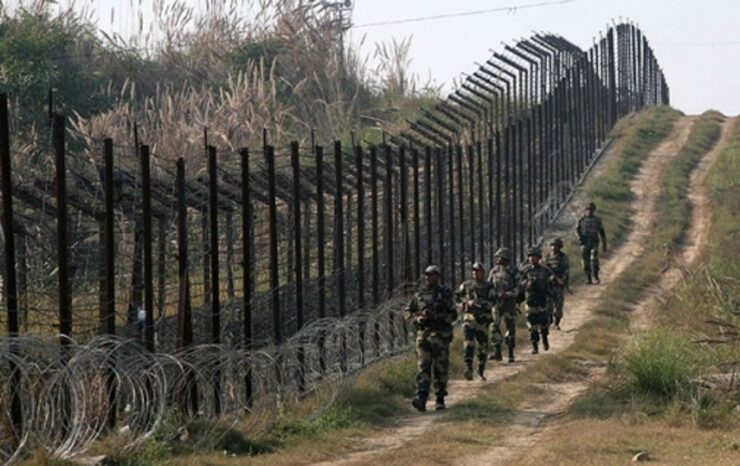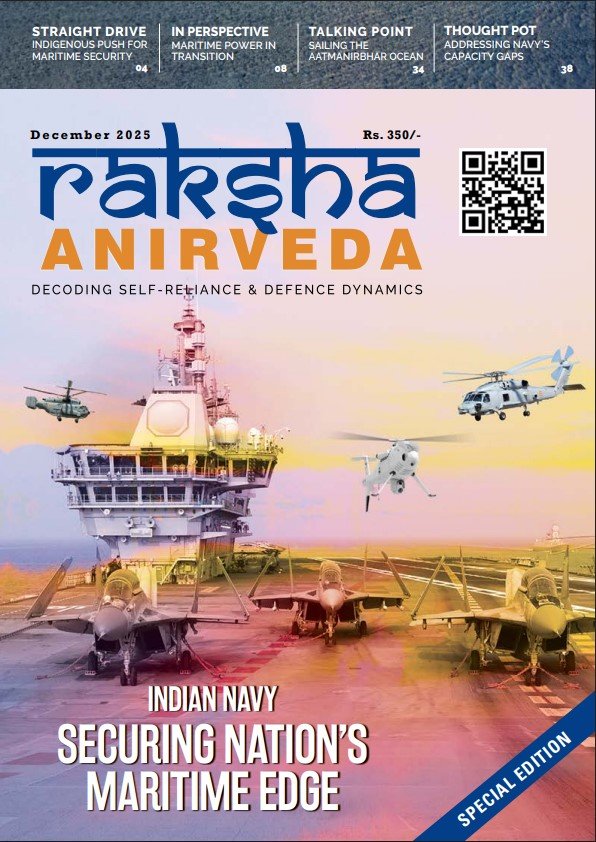“Strength respects strength and not weakness. Strength means military might and economic prosperity.”
― A.P.J. Abdul Kalam
India finds itself navigating a rapidly evolving security landscape, marked by dynamic challenges both externally and internally. The multifaceted security environment encompasses an assertive China on the Line of Actual Control (LAC), persistent friction with Pakistan along the Line of Control (LOC), internal security challenges, and multidomain grey zone threats, making the situation perilous. As India aspires to claim its place as Viksit Bharat@2047, the imperative for Surakshit Bharat to proactively address its security concerns becomes paramount.
Challenges to National Defence
China’s Assertive Posture: China remains the primary external threat, engaging India in a prolonged strategic contest. The ongoing diplomatic negotiations with India are seen as calculated efforts to erode India’s resources and resilience gradually. China employs subtle manoeuvres to undermine India’s growth story through regional alliances, blocking memberships, and backing insurgencies. The standoff along the LAC remains unresolved, with incidents diminishing but flashpoints like Demchok and Depsang Plains remain volatile. China’s steadfast stance on the vexed border problem since the 2020 intrusions, poses a glaring threat to India.
Pakistan’s Perpetual Challenge: Rooted in the partition of 1947, the Kashmir issue continues to be a flashpoint, with proxy wars and cross-border infiltrations persisting. Pakistan’s strategic culture, deeply rooted in its revisionist ideology and military primacy, poses a persistent challenge. Despite failed attempts, Pakistan’s efforts to create unrest in Jammu and Kashmir are likely to persist, serving the interests of the Pakistan Army and keeping the resolution of the Kashmir issue a distant prospect.
Collusive Threat: The deepening China-Pakistan relationship, often described as “higher than the mountains and deeper than the oceans,” presents a collusive threat for India. Collaborative efforts between the two nations reveal a synchronised anti-India approach, exposing India to the risk of a two-front war. Strategic preparedness and a robust defence posture become imperative to counter such a collusive threat.
China remains the primary external threat, engaging India in a prolonged strategic contest. China’s diplomatic talks with India are calculated efforts to erode India’s resources and resilience. China employs subtle manoeuvres to undermine India’s growth story through regional alliances, blocking memberships, and backing insurgencies
Internal Security Dynamics: Pakistan’s support for proxy wars in Jammu and Kashmir remains a persistent challenge, with recent escalations raising concerns. While insurgencies in many northeastern states have reduced, sustained efforts in governance, development, and continued security presence are required. Flashpoints like Manipur periodically escalate, with Chinese footprints in Myanmar adding to the complexities of the region.
Grey Zone Threats: Grey zone threats, including information warfare, cyber activities, and psychological operations, have become a reality of contemporary warfare. China has extensively used these tactics to subdue India’s power calculus in South Asia and the Indian Ocean Region. Pakistan’s employment of regulars, irregulars, and non-state actors in the conflict in Jammu and Kashmir exemplifies the multifaceted nature of grey zone threats.
Lessons from Global Conflicts
The global conflicts of 2024, such as the Israel-Hamas war and the Russia-Ukraine conflict, offer valuable insights and lessons for India to adapt to the evolving nature of warfare. These conflicts underscore several critical lessons:
Conventional Wars Are Here to Stay: Despite the changing nature of warfare, conventional wars and conflicts remain pervasive. Their character evolves with a tectonic shift in the goals, rules, players, and instruments of war. Proxies are frequently employed, and in today’s interdependent world, robust relationships provide inherent advantages.
Blurred Line between War and Peace: The line between war and peace has become increasingly blurred, with overlapping boundaries and unlimited players. Questions arise about how to identify when a nation is at war, who participates, the rules governing war, how to determine the winner, and how to recognise the end of a war.
Duration of Wars: Short wars are an illusion, and their duration is often longer than intended. The wars in Ukraine and Gaza exemplify this, highlighting the need for a re-evaluation of sensitivity to casualties and a rethinking of conflict timelines.
Wars require stamina and an indigenous responsive defence industrial base. Short wars are an illusion, and their duration is often longer than intended. The wars in Ukraine and Gaza exemplify this, highlighting the need for a re-evaluation of sensitivity to casualties and a rethinking of conflict timelines
War Stamina and Indigenous Defence Industrial Base: Wars require stamina and an indigenous responsive defence industrial base. The fatigue in never-ending wars underscores the critical vulnerability of lacking war stamina. Testing war stamina during peacetime becomes crucial, evaluating the surge capabilities and reserve stocks of the defence industry.
Victory in Information Warfare: The notion of victory is now a narrative of information warfare and perception management. Conflicts often lack a defined conflict termination profile, emphasising the need for endless war stamina in the 21st century.
Technology as a Force Multiplier: While technology acts as a force multiplier, over-reliance on it without the human in the loop can be a “fatal attraction.” Human intelligence (HUMINT) remains vital, and agencies dealing with counterterrorism should not neglect human assets even during peacetime.
Overconfidence Breeds Complacency: Overconfidence can lead to complacency, as seen in instances like Israel falling for its myth of military invincibility. It is essential to balance confidence with adaptability and readiness.
Challenges of Urban Warfare and Civil-Military Fusion: Large-scale urban warfare, the redefinition of drone warfare, the imperative of civil-military fusion in the battlespace, and the importance of adaptability in modern warfare are vital lessons. Uncertainty is a constant feature, and flexibility is crucial in military operations.

Strengthening the Military Posture: Imperatives
National Security Strategy: A well-defined ‘India First’ national security policy and strategy are imperative for a coherent, pre-emptive, and proactive strategic response. This strategy should be dynamic, adaptable, and inclusive, involving relevant stakeholders from government agencies, the private sector, and civil society.
Atmanirbharta and Defence Industrial Base: Investment in self-reliance and self-sufficiency with a focus on indigenous technology infusion is necessary. Testing war stamina during peacetime by evaluating the defence industry surge capabilities and reserve stocks is critical.
Realistic budgeting, self-reliance, joint doctrines, structures, and training are crucial to counter future threats. The full spectrum of national power is required to build a robust deterrence strategy. Diplomatic, information, military, economic, financial, intelligence and cyber capabilities must be intricately woven together across all domains of warfare
Multidomain Deterrence: Building a robust deterrence strategy requires leveraging the full spectrum of national power. Diplomatic, information, military, economic, financial, intelligence and cyber capabilities must be intricately woven together across all domains of warfare.
Adaptive Deterrence Strategies: Transformative deterrence strategies should be re-evaluated and adapted to integrate non-traditional threats. A blend of military strength, economic resilience, cybersecurity, and soft power is essential for effective deterrence.
Modernise Military Capabilities: Realistic budgeting, self-reliance, and joint doctrines, structures, and training are crucial for countering future threats. Investment in modernising the armed forces, focusing on advanced technology, C5ISR capabilities, and multi-domain joint force capability is imperative.
Counterterrorism and Intelligence Cooperation: Strengthening counterterrorism efforts through enhanced intelligence capabilities and international collaboration is vital. Coordinated efforts in intelligence sharing and joint operations are necessary to address the evolving threat landscape posed by non-state actors.
Cyber Resilience: Enhancing cyber-domain measures to protect critical infrastructure, sensitive information, and financial systems is paramount. Developing a robust cyber offensive and defensive strategy with pre-emptive, proactive, and preventive measures is essential for national security.
In conclusion, India faces multifaceted challenges in its security paradigm, demanding a comprehensive and adaptive approach to address both external and internal threats effectively. The lessons from global conflicts and the imperatives for strengthening the military posture provide a roadmap for India to navigate its security landscape in the 21st century.
-The author is a PVSM, AVSM, VSM has had an illustrious career spanning nearly four decades. A distinguished Armoured Corps officer, he has served in various prestigious staff and command appointments including Commander Independent Armoured Brigade, ADG PP, GOC Armoured Division and GOC Strike 1. The officer retired as DG Mechanised Forces in December 2017 during which he was the architect to initiate process for reintroduction of Light Tank and Chairman on the study on C5ISR for Indian Army. Subsequently he was Consultant MoD/OFB from 2018 to 2020. The Officer is a reputed defence analyst, a motivational speaker and prolific writer on matters of military, defence technology and national security.The views expressed are personal and do not necessarily carry the views of Raksha Anirveda
The author, a PVSM, AVSM, VSM has had an illustrious career spanning nearly four decades. A distinguished Armoured Corps officer, he has served in various prestigious staff and command appointments including Commander Independent Armoured Brigade, ADG PP, GOC Armoured Division and GOC Strike 1. The officer retired as DG Mechanised Forces in December 2017 during which he was the architect to initiate process for reintroduction of Light Tank and Chairman on the study on C5ISR for Indian Army. Subsequently he was Consultant MoD/OFB from 2018 to 2020. He is also a reputed defence analyst, a motivational speaker and prolific writer on matters of military, defence technology and national security. The views expressed are personal and do not necessarily carry the views of Raksha Anirveda






